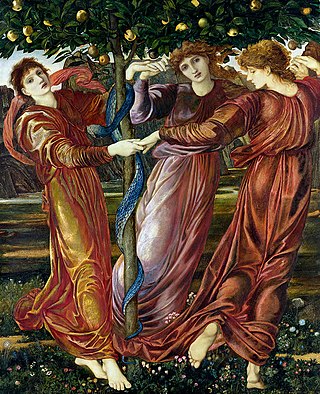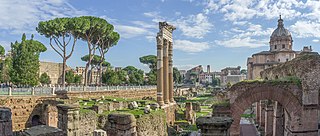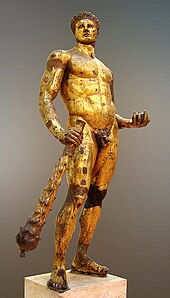
Hercules is the Roman equivalent of the Greek divine hero Heracles, son of Jupiter and the mortal Alcmena. In classical mythology, Hercules is famous for his strength and for his numerous far-ranging adventures.

In Greek mythology, the Hesperides are the nymphs of evening and golden light of sunsets, who were the "Daughters of the Evening" or "Nymphs of the West". They were also called the Atlantides from their reputed father, Atlas.

The Farnese Hercules is an ancient statue of Hercules, probably an enlarged copy made in the early third century AD and signed by Glykon, who is otherwise unknown; the name is Greek but he may have worked in Rome. Like many other Ancient Roman sculptures it is a copy or version of a much older Greek original that was well known, in this case a bronze by Lysippos that would have been made in the fourth century BC. This original survived for over 1500 years until it was melted down by Crusaders in 1205 during the Sack of Constantinople. The enlarged copy was made for the Baths of Caracalla in Rome, where the statue was recovered in 1546, and is now in the Museo Archeologico Nazionale in Naples. The heroically-scaled Hercules is one of the most famous sculptures of antiquity, and has fixed the image of the mythic hero in the European imagination.

The Mouth of Truth is a marble mask in Rome, Italy, which stands against the left wall of the portico of the Santa Maria in Cosmedin church, at the Piazza della Bocca della Verità, the site of the ancient Forum Boarium. According to enduring medieval legend, it will bite off the hand of any liar who places their hand in its mouth, or, alternatively, any who utters a lie while their hand is in the mouth. It still attracts many visitors who audaciously insert their hands.

Lysippos was a Greek sculptor of the 4th century BC. Together with Scopas and Praxiteles, he is considered one of the three greatest sculptors of the Classical Greek era, bringing transition into the Hellenistic period. Problems confront the study of Lysippos because of the difficulty of identifying his style among the copies which survive. Not only did he have a large workshop and many disciples in his immediate circle, but there is understood to have been a market for replicas of his work, supplied from outside his circle, both in his lifetime and later in the Hellenistic and Roman periods. The Victorious Youth or Getty bronze, which resurfaced around 1972, has been associated with him.

The Forum Boarium was the cattle market or forum venalium of ancient Rome. It was located on a level piece of land near the Tiber between the Capitoline, the Palatine and Aventine hills. As the site of the original docks of Rome, the Forum Boarium experienced intense commercial activity.

The Theatre of Pompey was a structure in Ancient Rome built during the latter part of the Roman Republican era by Pompey the Great. Completed in 55 BC, it was the first permanent theatre to be built in Rome. Its ruins are located at Largo di Torre Argentina.

The Dying Gaul, also called The Dying Galatian or The Dying Gladiator, is an ancient Roman marble semi-recumbent statue now in the Capitoline Museums in Rome. It is a copy of a now lost sculpture from the Hellenistic period thought to have been made in bronze. The original may have been commissioned at some time between 230 and 220 BC by Attalus I of Pergamon to celebrate his victory over the Galatians, the Celtic or Gaulish people of parts of Anatolia. The original sculptor is believed to have been Epigonus, a court sculptor of the Attalid dynasty of Pergamon.

The life-size ancient but much restored marble statue known as the Barberini Faun, Fauno Barberini or Drunken Satyr is now in the Glyptothek in Munich, Germany. A faun is the Roman equivalent of a Greek satyr. In Greek mythology, satyrs were human-like male woodland spirits with several animal features, often a goat-like tail, hooves, ears, or horns. Satyrs attended Dionysus.

The Temple of Hercules Victor or Hercules Olivarius ( is a Roman temple in Piazza Bocca della Verità in the area of the Forum Boarium near the Tiber in Rome. It is a tholos, a round temple of Greek 'peripteral' design completely surrounded by a colonnade. This layout caused it to be mistaken for a temple of Vesta until it was correctly identified by Napoleon's Prefect of Rome, Camille de Tournon.

François Duquesnoy or Frans Duquesnoy was a Flemish Baroque sculptor who was active in Rome for most of his career. His idealized representations are often contrasted with the more emotional character of Bernini's works, while his style shows a great affinity to Algardi's sculptures.

The study of Roman sculpture is complicated by its relation to Greek sculpture. Many examples of even the most famous Greek sculptures, such as the Apollo Belvedere and Barberini Faun, are known only from Roman Imperial or Hellenistic "copies". At one time, this imitation was taken by art historians as indicating a narrowness of the Roman artistic imagination, but, in the late 20th century, Roman art began to be reevaluated on its own terms: some impressions of the nature of Greek sculpture may in fact be based on Roman artistry.

The Forum of Caesar, also known by the Latin Forum Iulium or Forum Julium, Forum Caesaris, was a forum built by Julius Caesar near the Forum Romanum in Rome in 46 BC.

The Ludovisi Gaul is an ancient Roman statue depicting a Gallic man plunging a sword into his breast as he holds up the dying body of his wife. This sculpture is a marble copy of a now lost Greek bronze original. The Ludovisi Gaul can be found today in the Palazzo Altemps in Rome. This statue is unique for its time because it was common to depict the victor but instead, the Ludovisi Gaul depicts the defeated.

The Pasquino Group is a group of marble sculptures that copy a Hellenistic bronze original, dating to ca. 200–150 BCE. At least fifteen Roman marble copies of this sculpture are known. Many of these marble copies have complex artistic and social histories that illustrate the degree to which improvisatory "restorations" were made to fragments of ancient Roman sculpture during the 16th and 17th centuries, in which contemporary Italian sculptors made original and often arbitrary and destructive additions in an effort to replace lost fragments of the ancient sculptures.

In ancient Roman religion and myth, Hercules was venerated as a divinized hero and incorporated into the legends of Rome's founding. The Romans adapted Greek myths and the iconography of Heracles into their own literature and art, but the hero developed distinctly Roman characteristics. Some Greek sources as early as the 6th and 5th century BC gave Heracles Roman connections during his famous labors.

The Caves of Hercules is an archaeological cave complex located in Cape Spartel, Morocco.
The Hellenistic Prince, Seleucid Prince, or Terme Ruler is a Greek bronze statue, 204 centimetres high, made in the 2nd century BC, now in the collections of the Palazzo Massimo alle Terme in Rome. It was found in 1885, together with the Boxer at Rest, on the Quirinal Hill, probably near the Baths of Constantine during the construction of the National Theatre. The two statues were however not part of an ensemble, being of different dates. There are significant debates on who is the person pictured, the original attribution to a Hellenistic prince being now rejected in favour of a Roman general—possibly Scipio Aemilianus, although there have been other suggestions.

The Sanctuary of Hercules Victor in Tivoli (Italy) was one of the major complexes of the Roman Republican era built on the wave of the Hellenistic cultural influence after the final Roman conquest of Greece. It was built just outside the ancient city of Tibur and is the largest of Italic sanctuaries dedicated to Hercules, and the second in the whole Mediterranean after that of Cádiz in Spain. It was built between about 120 and 82 BC and was a masterpiece of Roman engineering with many innovations. Further building was done in the Augustan period especially in the theatre area. Augustus administered justice here on numerous occasions, under the arcades of the sanctuary.



















